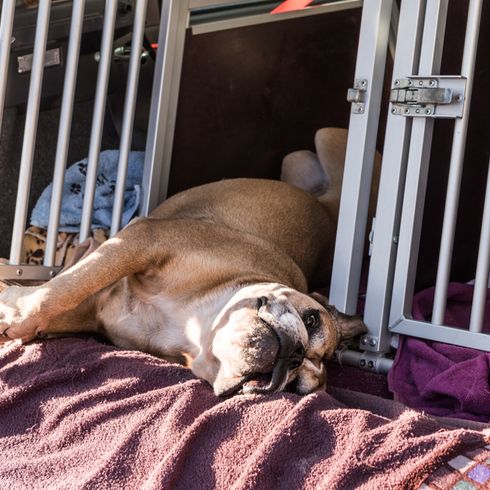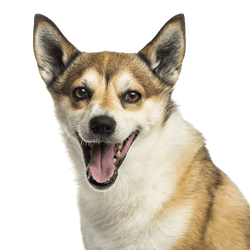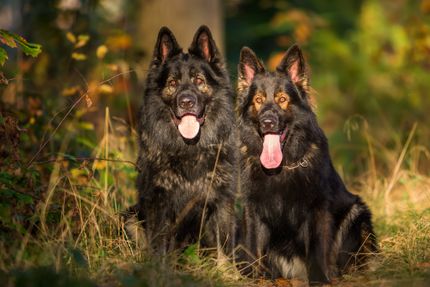
Continental Bulldog Breed description: Character & Co
Continental Bulldog
Facts & Origin
Origin of the Continental Bulldog
The Continental Bulldog is a relatively new breed of dog from Switzerland, which was bred with the thought of creating a Bulldog that meets the required criteria of the European Convention on the Breeding and Keeping of Pets and the Swiss Animal Welfare Act (Article 10). In the year 2000, voices were raised there to stop the breeding of the English Bulldog for animal welfare reasons, because they were getting more and more overbred. In order not to lose the popular breed of the Bulldog completely, there were efforts to create a new breeding direction, which should create a Bulldog with a healthy body. This idea quickly gained a lot of supporters in Switzerland and especially in Germany. Under strict supervision of the responsible societies the English Bulldog was crossed with the Old English Bulldog. After only a few years and various breeding successes, a dog was achieved that came very close to the original type of the Bulldog. In order to establish a clear distinction to the English Bulldog, the new breed was given the name "Continental Bulldog" and has enjoyed great popularity ever since.
FCI
The Continental Bulldog is a young dog breed from Switzerland, which has not yet been recognised by the FCI. Nationally, however, it has already been recognised in Germany by the VDH and a standard (VDH Standard No. 993) has been defined for them. In Switzerland too there exists a national standard for the still young breed.
The Continental Bulldog is a medium sized, athletic dog. It is a well-built Bulldog that is very agile and enduring despite its almost square build. The adorable Swiss is supposed to remind of the English Bulldog in character, which it does in the best possible way. In contrast to the English Bulldog, however, it has a healthy body that allows him to run and breathe freely. Physical activity does not present a problem to the agile four-legged friend, generally he compares more to the original Bulldog of the 19th century than to animals that win prizes at exhibitions. The tail of the Continental Bulldog is not crippled, but set low, it is strong and reaches about to the ankle. It can be straight or slightly curved, but is not carried curled-up over the back.




| Alternate Name | - |
| Origin | Switzerland |
| Life expectancy | 10 - 12 years |
| Care requirements | low-maintenance |
| Activity level | low |
| FCI group | Molossian type |
| AKC group | not recognised |
| KC group | not recognised |
Attitude, character and temperament of the breed
What are typical character traits of the Continental Bulldog?
If you decide to buy a Continental Bulldog, you will have a lovable and friendly dog by your side. The character of the new breed is very similar to the Old English Bulldog. It is considered to be a quiet type that goes through life with a lot of charm.
- It is a loving partner to his humans with an almost over-the-top friendliness.
- They likes to join you everywhere you go and accompanies their two-legged friends through thick and thin.
- As they also gets along very well with children and other animals, the Continental Bulldog is very suitable as a family dog.
- The strong four-legged friend is attentive and self-confident, never shy or aggressive.
- Because of its good-natured character, the Continental Bulldog is also suitable as a beginner's dog, provided you are committed and willing to face its temporary stubbornness and obstinacy with loving consistency.
Already as puppies, the Continental Bulldog must be set clear boundaries, that they strictly have to follow. Fully grown, the friendly four-legged companion is physically a very strong and sometimes stormy dog, so obedience to their human is even more important. From the beginning, a trusting relationship with the Bulldog should be built up, this way it is willing to let you lead the way. You won't get anywhere with them with forcefulness or harshness.
Character



Health and breeding information
What are typical diseases of the Continental Bulldog?
There are no known breed-specific diseases.
What should be considered in regards to Continental Bulldog breeding?
In Continental Bulldog breeding the health of the parents and the puppies is the main focus. With serious breeders you can visit the home of the animals, any questions you might have should get answered and the process of adopting a puppy will be discussed in detail. The Continental Bulldog puppies should be chipped, dewormed several times and vaccinated. They should have pedigree papers, a vaccination certificate and a health certificate.


Appearance and coat of the Continental Bulldog
The top coat of the Continental Bulldog is short, smooth, shiny, dense and not bristly. The undercoat should be short, fine and dense, but not every dog has one. Concerning the colours there is a great variety in this young breed. Nearly all colours - with the exception of blue - are permitted according to the VDH standard. The following variations are permitted:
- monochrome
- combination with white
- brindle
- with or without black mask
- no particular stain pattern
The nose of the Swiss four-legged friend should be black.
What is the average size of a Continental Bulldog?
The withers height for males should be 42-46 centimetres. Bitches are slightly smaller with a size of 40-44 centimetres.
How much does a Continental Bulldog weigh?
The weight of an adult Continental Bulldog lies between 20 and 30 kilograms.
What is the average life expectancy of a Continental Bulldog?
The average life expectancy of the Continental Bulldog is 10 to 12 years.
| Fur length | short |
| Fur | flat coated |
| Ear shape | Tilt-ear |
| Tail | stubby |
| Anatomy | rugged, massive, hefty |
| Size ♀ | 40 - 44 cm |
| Weight ♀ | 22 - 27 kg |
| Size ♂ | 42 - 46 cm |
| Weight ♂ | 25 - 30 kg |
| Suitable For | Beginner |
Colors






Other medium dogs
Useful Articles

You can find articles that might interest you in the dogbible blog to match your favorite breed.
Visit our magazineto stay up to date on dog trends.
To find out more, view our Privacy Policy
Find here the breed that suits you and find out what character traits it has. Here you can also learn more about the origin, size and weight of your favorite breeds.
Matching your favorite breed, you'll find articles that might interest you on the dogbible dog blog.
Ear infection in dogs - 5 tips and prevention of inflammation
Dog and zodiac sign - which breed suits your zodiac sign?
Female Dog in Heat - what is it?





















